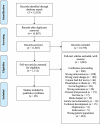Virtual Reality for the Treatment of Anxiety Disorders: A Scoping Review
- PMID: 34817595
- PMCID: PMC8742249
- DOI: 10.5014/ajot.2021.046169
Virtual Reality for the Treatment of Anxiety Disorders: A Scoping Review
Abstract
Importance: Virtual reality in head-mounted displays (HMD-VR) may be a valuable tool in occupational therapy to address anxiety. Findings from the virtual reality exposure therapy (VRET) literature may facilitate translation of HMD-VR to occupational therapy psychosocial practice.
Objective: To explore how HMD-VR has been used to treat anxiety through VRET and could be translated to occupational therapy.
Data sources: We searched seven electronic databases for articles published between 2000 and 2020: CINAHL, Cochrane Library, Embase, ERIC, Ovid MEDLINE, PsycINFO, and Web of Science. Search terms included HMD-VR constructs, products, and therapy concepts. Study Selection and Data Collection: We used Preferred Reporting Items for Systematic Reviews and Meta-Analyses guidelines to report studies implementing VRET to treat anxiety. At least two reviewers assessed each citation, and a third resolved disagreements. Articles were included if they were in English, reported experimental data, and used HMD-VR. Letters, commentaries, book chapters, technical descriptions, theoretical papers, conference proceedings (≤4 pages), and reviews were excluded.
Findings: Twenty-eight studies used HMD-VR to treat posttraumatic stress disorder (n = 3), specific phobias (n = 19), and performance-based social anxiety (n = 6); protocols and levels of evidence varied (randomized controlled trials, n = 11; controlled trials without randomization, n = 6; case-control or cohort studies, n = 11). Qualitative examination indicates HMD-VR is an effective treatment tool.
Conclusions and relevance: HMD-VR can be a valuable tool for occupational therapy to simulate environments where clients with anxiety disorders participate. Eliciting presence through multisensory features and body representation may enhance outcomes. What This Article Adds: Drawing from the VRET literature, this scoping review suggests that HMD-VR can be used by occupational therapy practitioners to simulate ecologically valid environments, evaluate client responses to fearful stimuli, and remediate anxiety though immersion in virtual tasks when participation in natural contexts is unfeasible. Having ecologically valid environments is particularly important for people with anxiety disorders because they need support to cope when they encounter triggers in everyday life environments.
Copyright © 2021 by the American Occupational Therapy Association, Inc.
Figures



Similar articles
-
Applications of Head-Mounted Displays for Virtual Reality in Adult Physical Rehabilitation: A Scoping Review.Am J Occup Ther. 2020 Sep/Oct;74(5):7405205060p1-7405205060p15. doi: 10.5014/ajot.2020.041442. Am J Occup Ther. 2020. PMID: 32804624 Free PMC article.
-
Implementations of Virtual Reality for Anxiety-Related Disorders: Systematic Review.JMIR Serious Games. 2018 Nov 7;6(4):e10965. doi: 10.2196/10965. JMIR Serious Games. 2018. PMID: 30404770 Free PMC article. Review.
-
Virtual reality exposure therapy for anxiety and related disorders: A meta-analysis of randomized controlled trials.J Anxiety Disord. 2019 Jan;61:27-36. doi: 10.1016/j.janxdis.2018.08.003. Epub 2018 Aug 10. J Anxiety Disord. 2019. PMID: 30287083
-
[The application of virtual reality in the treatment of mental disorders].Nervenarzt. 2023 Jan;94(1):27-33. doi: 10.1007/s00115-022-01378-z. Epub 2022 Sep 2. Nervenarzt. 2023. PMID: 36053303 Free PMC article. Review. German.
-
The Use of Virtual Reality Through Head-Mounted Display on Balance and Gait in Older Adults: A Scoping Review.Games Health J. 2021 Feb;10(1):2-12. doi: 10.1089/g4h.2019.0159. Epub 2020 Jun 29. Games Health J. 2021. PMID: 32598189
Cited by
-
Virtual reality in the management of stress and anxiety disorders: A retrospective analysis of 61 people treated in the metaverse.Heliyon. 2023 Jul 7;9(7):e17870. doi: 10.1016/j.heliyon.2023.e17870. eCollection 2023 Jul. Heliyon. 2023. PMID: 37483756 Free PMC article.
-
The Utility of Virtual Reality in Ophthalmology: A Review.Clin Ophthalmol. 2025 May 21;19:1683-1692. doi: 10.2147/OPTH.S517974. eCollection 2025. Clin Ophthalmol. 2025. PMID: 40417137 Free PMC article. Review.
-
An Immersive Virtual Reality Intervention for Preoperative Anxiety and Distress Among Adults Undergoing Oncological Surgery: Protocol for a 3-Phase Development and Feasibility Trial.JMIR Res Protoc. 2024 May 14;13:e55692. doi: 10.2196/55692. JMIR Res Protoc. 2024. PMID: 38743939 Free PMC article.
-
Virtual Reality as a Moderator of Psychedelic-Assisted Psychotherapy.Front Psychol. 2022 Mar 4;13:813746. doi: 10.3389/fpsyg.2022.813746. eCollection 2022. Front Psychol. 2022. PMID: 35310225 Free PMC article. Review.
-
Aplicaciones del metaverso en medicina y atención sanitaria.Adv Lab Med. 2024 Feb 19;5(2):166-172. doi: 10.1515/almed-2024-0004. eCollection 2024 Jun. Adv Lab Med. 2024. PMID: 38939208 Free PMC article. Spanish.
References
-
- *Abdullah, M., & Shaikh, Z. A. (2018). An effective virtual reality based remedy for acrophobia. International Journal of Advanced Computer Science and Applications , 9, 162–167. 10.14569/IJACSA.2018.090623 - DOI
-
- American Occupational Therapy Association. (2016). Occupational therapy’s role in mental health recovery. https://www.aota.org/About-Occupational-Therapy/Professionals/MH/mental-...
-
- American Psychiatric Association. (2013). Diagnostic and statistical manual of mental disorders (5th ed.). American Psychiatric Publishing. 10.1176/appi.books.9780890425596.dsm05 - DOI
Publication types
MeSH terms
Grants and funding
LinkOut - more resources
Full Text Sources
Medical

